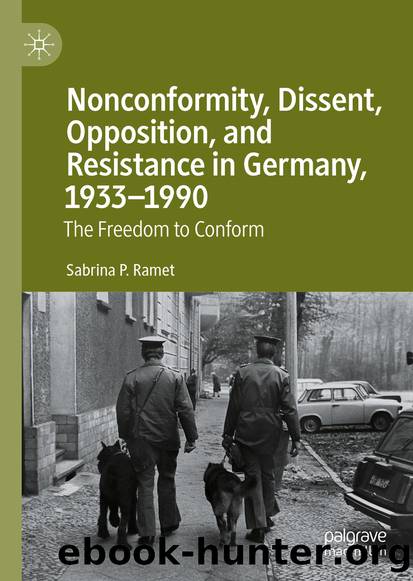Nonconformity, Dissent, Opposition, and Resistance in Germany, 1933â1990 by Sabrina P. Ramet

Author:Sabrina P. Ramet
Language: eng
Format: epub
ISBN: 9783030554125
Publisher: Springer International Publishing
Art and Music
The effort to reshape identities and promote the idea that Germans in the SBZ were fashioning an anti-fascist nation was manifested not only in the religious sphere and the sphere of gender equalityâalbeit contested in both casesâbut also in the cultural sphere. In the first three years after the war, however, there was a degree of liberal toleration in culture, with the journal Bildende Kunst, edited by Karl Hofer and Oskar Nerlinger, publishing favorable articles about the works of Pablo Picasso, the Dadaist painter Max Ernst, the post-impressionist painter Georges-Pierre Seurat, the Cubist painter Juan Gris, the expressionist painter Lyonel Feininger, and other free spirits. An article by Adolf Behne, published in the journal in 1948, defended abstract art against those who would want to put artists in ideological straightjackets, and Hofer himself produced abstract art , in particular a painting showing four abstract figures dancing in front of a partially ruined historical building, with one of the figures dancing headless, while a second was shown holding the missing head. But toward the end of 1948, Lt. Col. Alexander Dymschitz took over as head of SMADâs cultural department; with that, the artistic freedom enjoyed since 1945 came to an abrupt end.109
From the standpoint of the Soviet authorities and their SED acolytes , there were progressive cultural products, which moved society upward along the socialist path, as well as reactionary cultural products, which obstructed the social transformation of society. Small art exhibitions came under fire in the Soviet-zone press, with the works on display condemned for lack of social engagementââformalism â in the Soviet jargon. An exhibit in West Berlin in particular came under fire in the Tägliche Rundschau for âlifeless formalismâ and for failing to display even a âtrace of understanding for liberated Germanyâs awakening from nazism to true humanity and democracy.â110 The Deutsche Volkszeitung likewise served as a vehicle for rebuking artists, excoriating them in August 1945 for not expressing optimism about the future, while insisting two months later, âWe have no use for surrealism or any other kind of ism; we need an art representing life in a fashion that renders all its hidden interconnections more profoundly and in a thoroughly understandable fashion to the viewer, not less so or entirely incomprehensible.â111 The Soviets had no use for the works of Picasso, Matisse, Chagall, and Klee, or likewise for the music of Hindemith and Schoenberg. The ideal, from the Soviet point of view, was to see art âcompletely directed by the party.â112
In fact, in the sphere of culture, there was only one âism,â which the Soviet authorities enthusiastically endorsedâsocialist realism , which required that artistic creations, whether paintings or sculpture or music, represent everyone and everything associated with socialism as heroic and triumphant, while linking capitalism with exploitation, injustice, imperialism, war, and suffering. SMAD Order No. 51 (1945) was devoted to setting the course in the cultural sector, demanding in particular the âactive utilization of artistic means in the struggle against fascism and for the reeducation of the German people.
Download
This site does not store any files on its server. We only index and link to content provided by other sites. Please contact the content providers to delete copyright contents if any and email us, we'll remove relevant links or contents immediately.
| Africa | Americas |
| Arctic & Antarctica | Asia |
| Australia & Oceania | Europe |
| Middle East | Russia |
| United States | World |
| Ancient Civilizations | Military |
| Historical Study & Educational Resources |
The Third Pole by Mark Synnott(709)
Money for Nothing by Thomas Levenson(663)
The Economist (20210109) by calibre(624)
Christian Ethics by Wilkens Steve;(607)
Made in China by Anna Qu(585)
100 Posters That Changed The World by Salter Colin T.;(540)
The Irish Buddhist by Alicia Turner(527)
Reopening Muslim Minds by Mustafa Akyol(520)
The Age of Louis XIV: The Story of Civilization by Will Durant(508)
Routledge Handbook of Contemporary India by Knut A. Jacobsen(504)
Nonstate Warfare by Stephen Biddle(499)
Ideology by Eagleton Terry;(492)
Culture by Terry Eagleton(490)
The Great Pyramid Void Enigma by Scott Creighton(486)
The Shortest History of China by Linda Jaivin(471)
Objects of Vision by Saab A. Joan;(460)
Banaras: CITY OF LIGHT by Diana L. Eck(456)
The Jews of Silence: A Personal Report on Soviet Jewry by Elie Wiesel(454)
Sybille Bedford by Selina Hastings(451)
